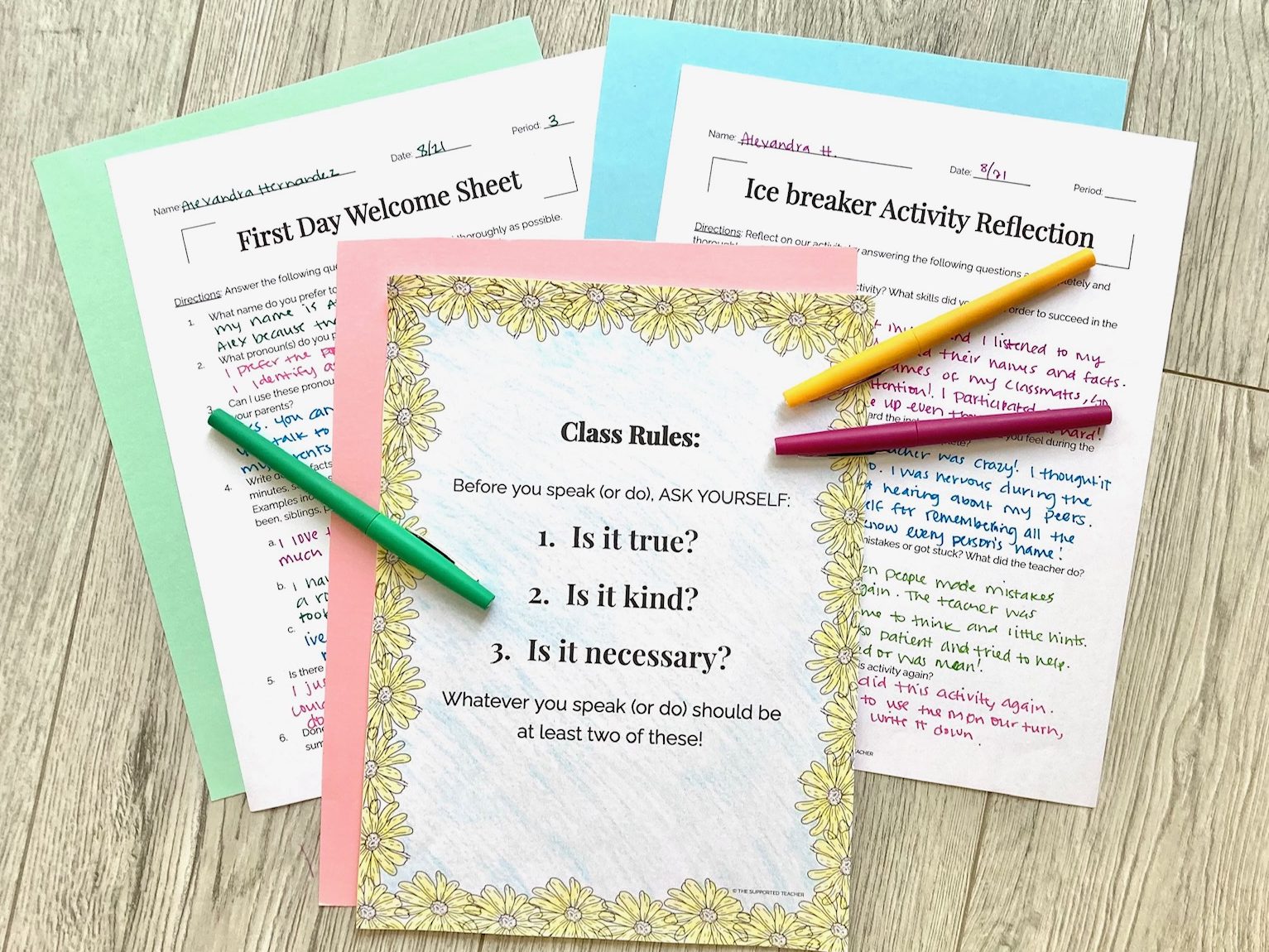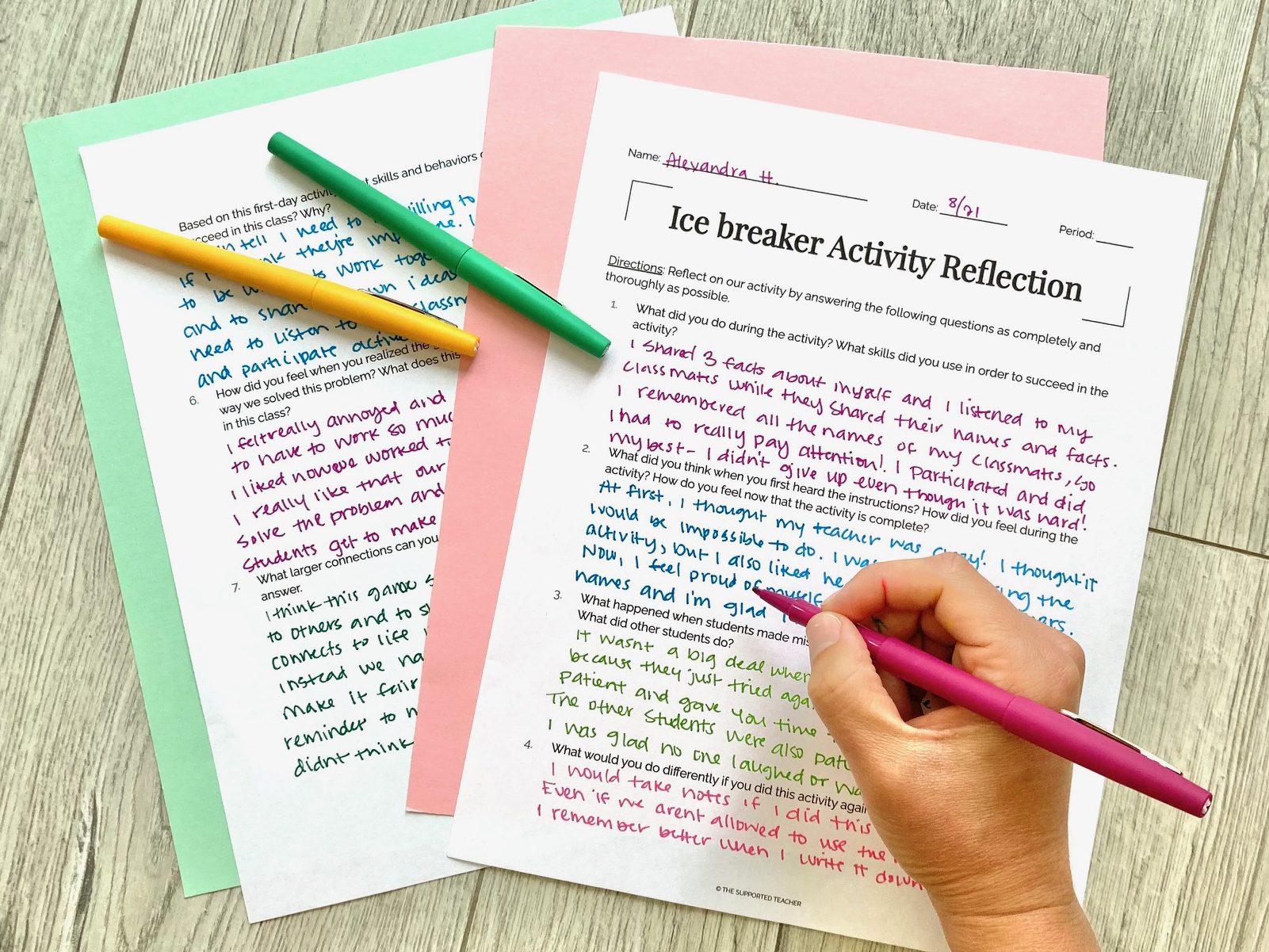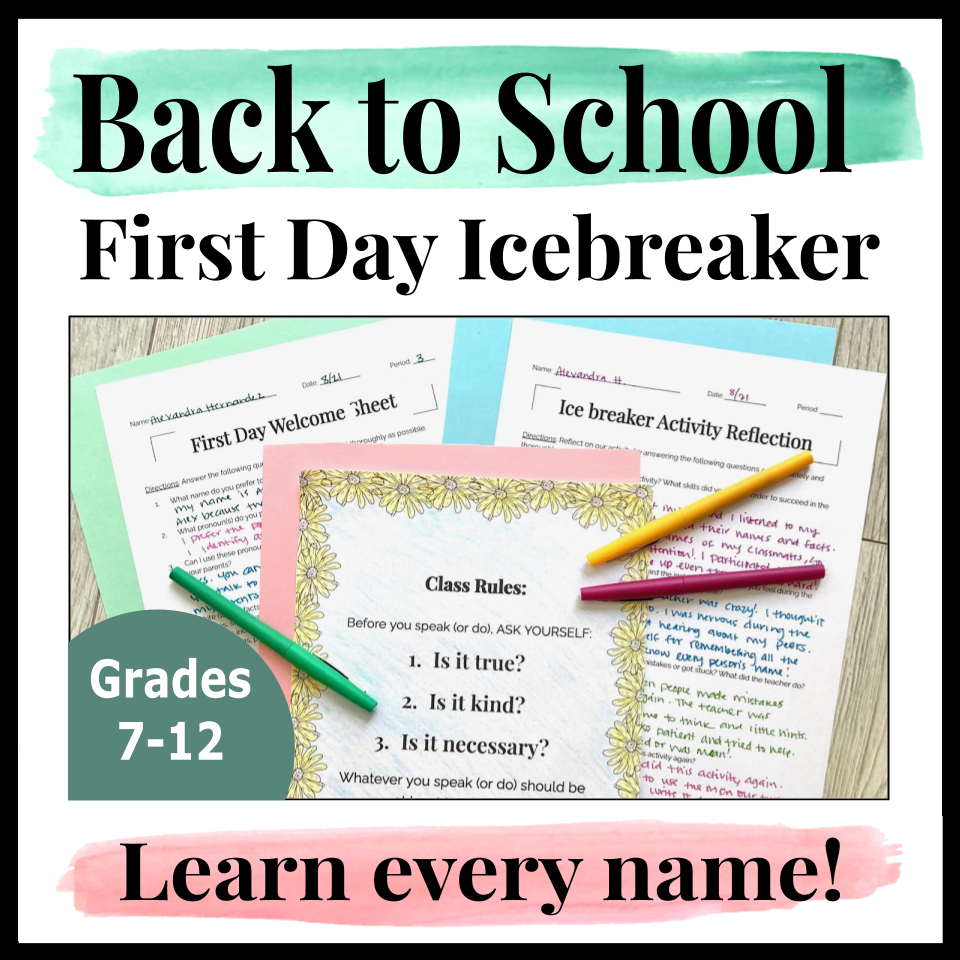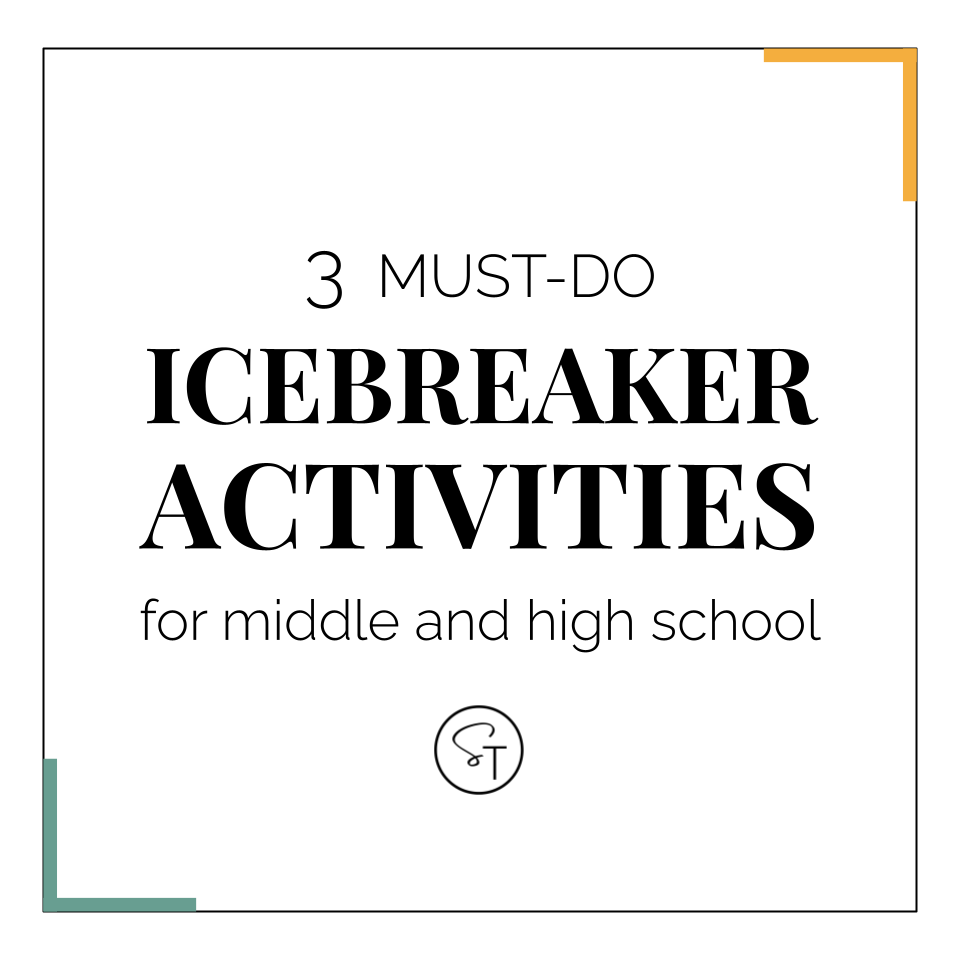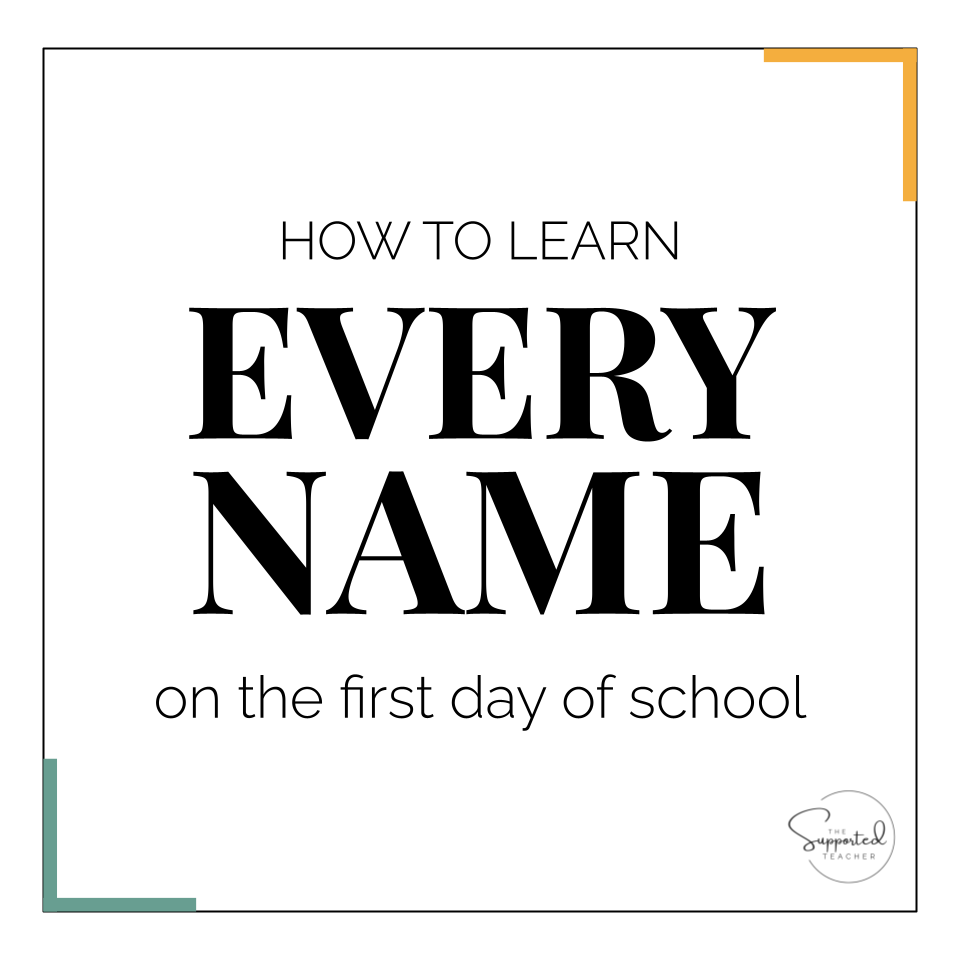The first day of school is exciting, fun, and …. let’s be honest here … a little nerve wracking.
How will you learn all of your students’ names (a massive feat for those of us teaching middle and high school)? How will you get to know your students and make students comfortable in your classroom and with each other? How will you balance building relationships with setting boundaries and expectations?
The average high school teacher has over 150 students (many with upwards of 200), making it a daunting task to learn each student’s name, ability level and needs, and personality.
But what if you could learn all of that in just one day?
I’ve tried a LOT of icebreakers and my hands-down favorite icebreaker for the first day of school is the Name Game because I’ve found the version that’s actually fun and actually works.
Why this Icebreaker Rocks
Ok. I know name games get a pretty bad wrap.
And rightfully so.
If you have a negative opinion of the name game, you’ve probably been forced to think of cheesy alliterative adjectives to go with your name that also somehow describe you, while praying the nickname doesn’t actually stick.
Maybe you’ve played name games asking you to throw a ball around a circle as you say the person’s name. If you’re like me, you defaulted to the same students each time to avoid the embarrassment of making mistakes in front of the class.
But this version of the name game is different.
It’s simple to play, requires no prep (or props!), and students really have to pay attention and be engaged.
Plus, you’ll know every single student’s name by the end of the first day – a major accomplishment (and stress reducer) when you teach middle and high school.
Knowing every name also makes a huge difference in classroom management and community building because anonymity creates an environment ripe for behavior issues.
When you know every students’ name (and so does everyone else in the class), students not only know they’ll be held responsible for their actions, they also want to be more responsible because they see the space as a community.
The best thing about the name game (besides helping me learn every name and setting expectations) is that I can really see my students’ personalities: I can see who gives up right away, who gets silly, who struggles with basic recall, who gets a little…testy, who has trouble paying attention…
By the time the game ends, I feel like I truly know each student. I gain SO much information about students in terms of both ability and personality just from playing this game. In parent meetings during the first few weeks of school, my colleagues regularly express surprise at how much I know about my students – and most of it I learned on the very first day!
How to Play the Name Game
In its simplest form, students state their own name before listing all of the students who have already had their turn. Pretty simple, right?
But just learning names would be a little boring, right? Plus, how well are we really breaking the ice if all we’ve learned is a person’s name? Not well, my friends.
So to help students really make connections, I ask students to share 3 facts about him or herself. The only rule I have around this is that the facts must be school appropriate. That’s it.
I don’t require every fact to be different from other students or ask students to think of strange or unusual facts. Their facts can be as unique or as bland as they want – whatever makes them feel safe on the first day in a room full of new classmates.
So to recap, in this modified version, each student shares:
- their own name
- 3 facts about themselves
- and the names of the students who have already shared
I always make a 3-slide slideshow with my 3 facts and a few photos. This serves as both a model for students to follow and as a way to help students learn a little more about me (without going into a long boring monologue of my life story).
This game is great because it’s SO simple and it gets every single student in your class speaking, sharing ideas, listening actively, and participating on the very first day, which is HUGE in establishing classroom norms and expectations (and laying the foundation for classroom management) early on in the year.
The Icebreaker Plot Twist
Here’s the thing.
Around halfway through the game, students will start to realize the game isn’t “fair.”
Students who have already gone will realize they no longer need to pay attention, since they’re “done.” Students who are going last will realize that they have 30 or more names to remember, while those who went first only had to remember a handful of names.
When I’m pretty sure a few students have realized the game is rigged, I ask my students (in a conspiratorial tone, of course): “Have you figured it out yet?”
Some students look around confused, but inevitably, one or two students answer immediately, “Yes! This game isn’t fair!”
Invite these students to explain it to the rest of the class.
Then ask your class, “How are we going to make this fair?”
I have had students suggest giving a test at the end, having the entire first row (or two!) go again – this time saying all the names, and allowing the last 5 students to call on students of their choice to say the names, and more.
Decide if you’ll pick the solution that works best or put it to a class vote.
Proceed accordingly.
Debrief and Reflect
When you’ve finished the game, it’s time to debrief.
Playing the game is great in itself is a great start to the new school year:
- You’ll know every name and a few facts
- You’ll have a really strong sense of each student’s personality
- And you’ll have a pretty good sense of which students you’ll be able to rely on as helpers, and which will need extra support during the year.
But the magic really happens when you and your students discuss the activity and reflect on everything going on in the game.
Be sure to end the game with at least a few debrief questions, which guide students to make connections between the game, your class, and life in a more broad sense.
Here are a few questions you might ask:
- What did you do during the activity? What skills were required?
- What did you think when you first heard the instructions? How did you feel during the activity? How do you feel now that the activity is complete?
- What happened when students made mistakes or got stuck?
- What happened when the class realized the game wasn’t “fair”? What does this experience tell you about how things work in this class?
Ultimately, you want students to understand that in this class, they listen actively, participate, try their best (even if it’s hard!), respect and help each other, share ideas and experiences, speak up when they see something unjust, and work together towards creating something more fair.
Students will leave your class on the first day knowing their names and stories matter in this space.
Want some ready-made materials to go with this game?
I’ve created several no-prep materials for implementing the Name Game Icebreaker including a Welcome Survey for students, a student-friendly slideshow with directions for playing the game and a template for displaying your 3 facts and photos, and a Name Game Debrief assignment to prepare students for a post-game discussion and reflection. Click the image below to check it out!
Looking for more fun icebreaker options? Read about my 3 favorite icebreakers for the first day of school here!

